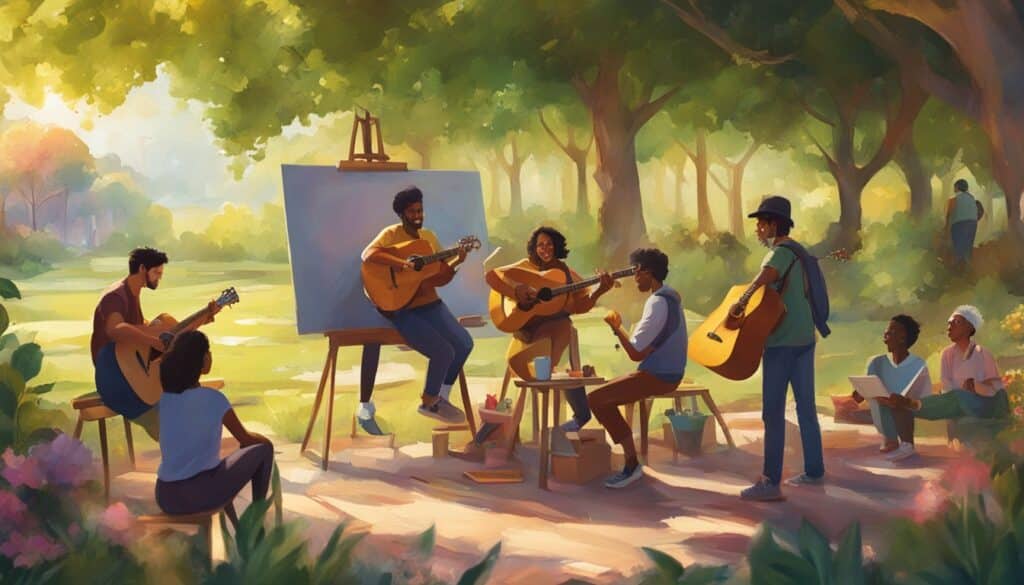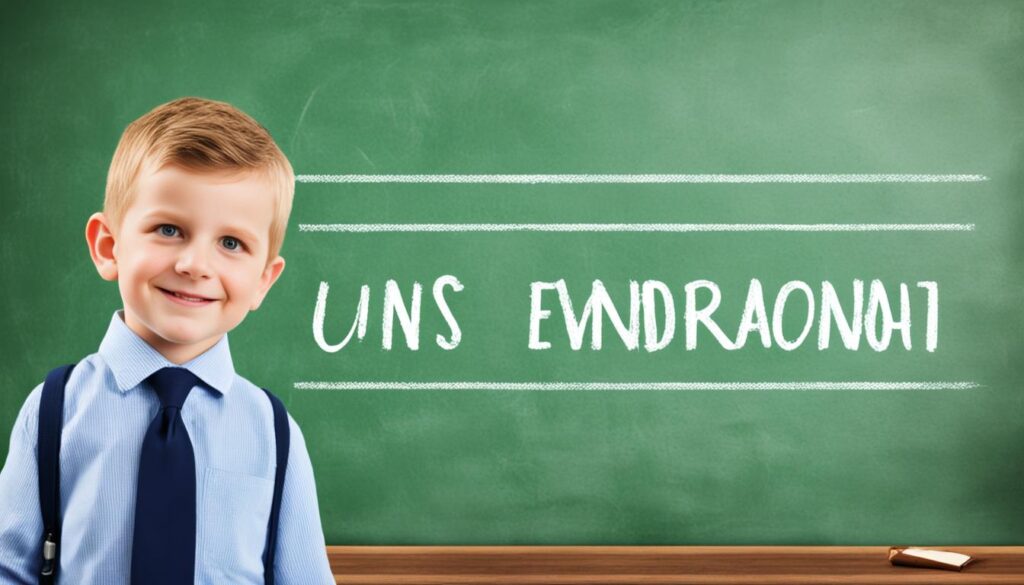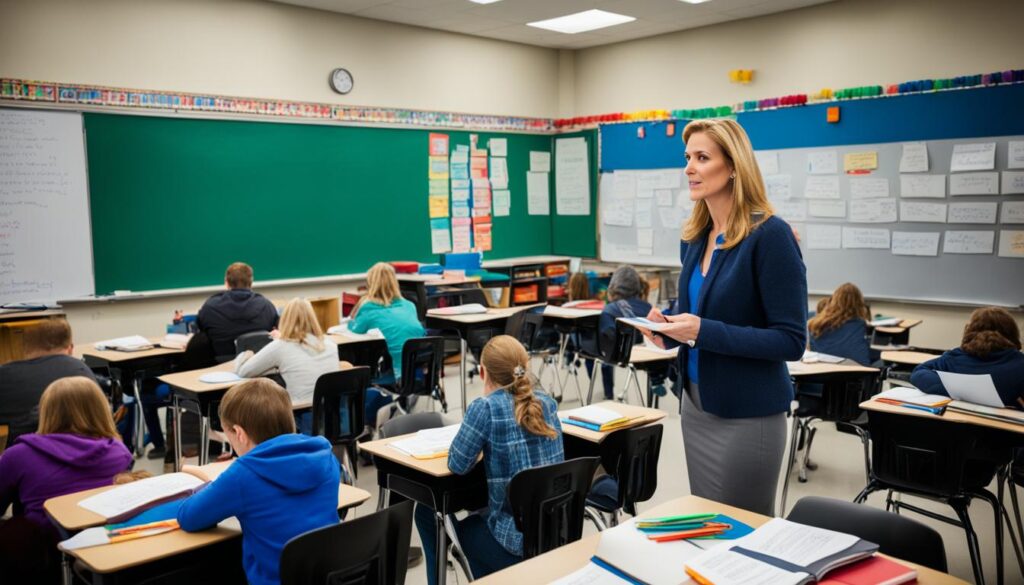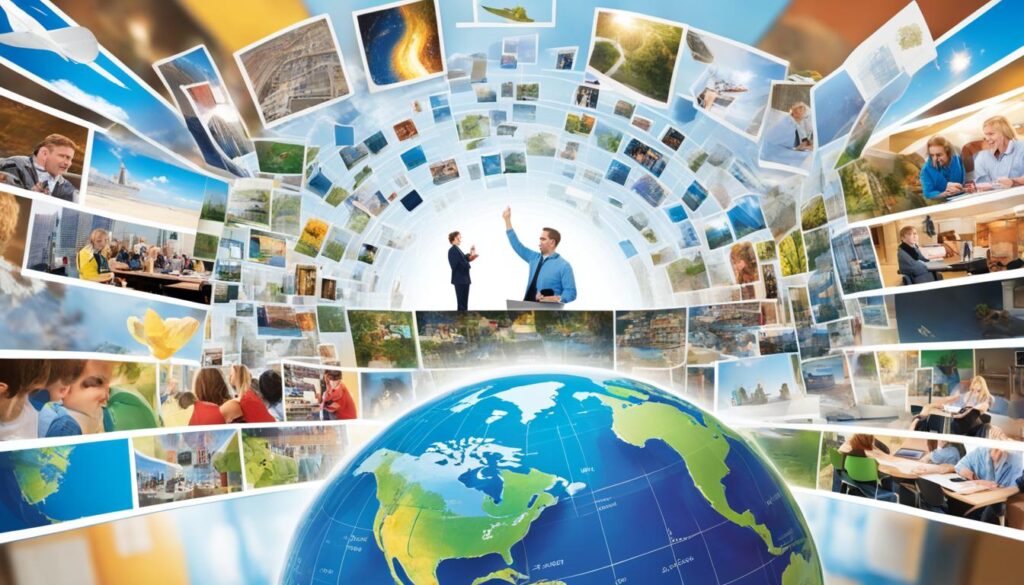Table of Contents
ToggleEducation brings positive changes in life. It is a process to acquire and share knowledge. Through education, we learn to think, understand right, and wrong. This knowledge is a path to move forward. It helps us be creative and solve problems to reach our aims.
There are three main types of education: formal, informal, and non-formal. Each type has its own way and goal to teach. Knowing about these types helps people choose how they want to learn.
Key Takeaways
- Education is a gradual process that brings positive changes in human life and behavior.
- The three main types of education are formal, informal, and non-formal.
- Formal education takes place in a structured, hierarchical setting like schools and universities.
- Informal education occurs through practical experiences and observing others outside of formal institutions.
- Non-formal education refers to organized learning programs that exist outside the formal school system.
Introduction to Education
Education is seen as a path towards growth and freedom. By learning specific skills, values, and principles, people become more productive and successful. The definition of education includes how we learn and think, not just what’s in a classroom.
Definition of Education
Education changes our lives and how we act, enhancing our personal traits. It opens a door for us to explore and share our own ideas. Also, education helps us know what’s right and wrong, leading us to improve.
Importance of Education
Education allows us to learn new things and solve problems creatively. It’s how we get to express ourselves and grow, aiming for success in our personal and professional lives.
Education as a Gradual Process
Education is not just what happens in school. It’s a lifelong journey, helping us improve as individuals. This journey includes learning new skills and ideas that make us better people.
Also Read : What Skills Are Required For A Mechanical Engineer Job?
Types of Education

Three main types of education exist: formal, informal, and non-formal. Each one has its own way and purpose to teach knowledge and skills.
| Type of Education | Definition | Examples |
|---|---|---|
| Formal Education | Structured, institution-based learning that follows a set curriculum and leads to recognized certificates or degrees. | Elementary, secondary, and higher education in schools, colleges, and universities. |
| Informal Education | Learning that occurs outside of a structured educational setting, often through daily experiences, interactions, and self-directed study. | Learning from parents, reading books, browsing educational websites, and acquiring skills through hobbies and extracurricular activities. |
| Non-formal Education | Organized educational activities that take place outside the formal school system, often focused on practical, vocational, or community-based learning. | Adult literacy courses, community-based educational programs, online learning, and professional development workshops. |
Each type of education differs in how it’s organized, its aims, and how it’s taught. Yet, they all help people learn and grow. Knowing what makes each type of education special helps learners pick what’s right for them.
Also Read : Explore More, Spend Less: Budget Travel Strategies
Formal Education

Formal education is what kids get in schools. It includes everything from elementary school to higher education. Students learn in a structured way, building on their knowledge each year.
Definition of Formal Education
It’s a system set up for learning. There’s a clear plan and things to learn each year. Students move up each year, following a set path. This path is taught by teachers in a well-organized system.
Examples of Formal Education
Think of sitting in classes from elementary school to high school and beyond. Getting a degree or a certification is also formal education. It’s all about learning step by step and getting proof you know stuff. This proof can help you get a job.
Characteristics of Formal Education
Formal education is about learning different subjects as they get harder each year. It’s a clear system from start to finish. You go through classes and grades in order, learning more as you go.
Advantages of Formal Education
Formal education keeps things organized. It helps you learn lots step by step. Plus, you get certificates that show what you’ve learned. These can help when you’re looking for a job. It also teaches you to think and solve problems.
Disadvantages of Formal Education
Getting bored and falling into bad habits can happen in formal education. It’s also not great if what you’re learning doesn’t fit what you want to do. It can be expensive and not very flexible. Personalized learning might be hard to find.
Also Read : Top 10 Must-visit Traveling For Adventure Seekers
Informal Education

Informal education is all about learning outside of school. It happens through watching, doing, and experiencing things. This way of learning is not from a set method in schools.
It’s learning without the rules of a classroom. People gain knowledge and skills in their own way. There’s no need to follow someone else’s plan. It’s learning as life goes on.
Examples of Informal Education
Some common examples of informal education include:
- Parent teaching a child valuable life skills
- Learning from reading books, articles, or websites
- Acquiring knowledge through daily experiences and observations
- Participating in community-based programs, such as scouts or fitness clubs
- Engaging in self-directed research and individual study
Characteristics of Informal Education
Informal education stands out in a few ways:
- It is not bound by any specific institution or organization.
- There is no set curriculum, timetable, or syllabus to follow.
- It does not involve the payment of fees or the attainment of certificates/degrees.
- The learning process is natural, flexible, and based on personal interests and needs.
- Informal education can happen anywhere, at any time, and through various methods.
Advantages of Informal Education
Informal education has its perks:
- It costs less than formal education.
- Learners can follow what they love and learn at their speed.
- It helps learn things that are useful in the real world.
- Informal education is open to everyone, no matter their age or background.
- It sparks a love for learning that lasts a lifetime.
Disadvantages of Informal Education
Yet, there are downsides to informal education:
- Lack of organization can sometimes mean not getting all the facts.
- Learning without a clear plan can feel messy and aimless.
- Informal education might not be as serious as formal schooling.
- There’s no formal test to show what you’ve learned this way.
- It might be hard to use what you’ve learned informally in a job.
Also Read : Top MBA Scholarship Programs To Fund Your Business Education
Non-formal Education

Non-formal education happens outside regular schools. It includes many programs. They meet the needs of many people, regardless of age or schooling.
Definition of Non-formal Education
Non-formal education is any learning done not in a regular school. It’s adaptable and practical. Skills often include work or life skills.
Examples of Non-formal Education
Non-formal education examples are basic adult and literacy classes. Others are fork preparation, home schooling, and distant learning. Non-formal programs can be local adult courses or ones for free. Some are run by groups like the Scouts or gyms.
Characteristics of Non-formal Education
Non-formal education is outside regular schools. It has a flexible schedule and focuses on real-life skills. Any age can join and it might have small costs. This way of learning is very practical. It usually means learning by doing, and not by tests.
Advantages of Non-formal Education
Non-formal education is very flexible and real-world focused. It fits anyone and teaches skills for life and work. It encourages people to take charge of their learning.
Disadvantages of Non-formal Education
Yet, it has its issues. The learning can be inconsistent because it’s not the same everywhere. Also, without certificates, some people might not see it as important.
Also Read : Scholarships For Online MBA Programs: A Complete Guide
Types of Education

Formal vs. Informal vs. Non-formal Education
Formal education is learning in schools or college, with set subjects and exams. It follows a clear path, leading to diplomas or degrees. On the other hand, informal education happens naturally. It’s the things you learn from daily life, like how to fix a bike. Non-formal education is somewhere in-between. It’s learning through courses, but not in a regular school. All three types have good and not-so-good sides.
Choosing the Right Type of Education
Choosing an education path is personal. Sometimes, mixing different types works best. This balanced approach uses formal, informal, and non-formal learning. It helps you become well-rounded and skilled. Such integrated learning is a smart move.
| Formal Education | Informal Education | Non-formal Education |
|---|---|---|
| Structured, hierarchical system of learning within an institution | Natural, experiential process that takes place outside of school | Organized learning that occurs separately from the formal school system |
| Follows a set curriculum and schedule | Lacks a structured curriculum or timetable | Offers flexible, adjustable curricula and schedules |
| Leads to recognized degrees and certifications | Does not result in formal qualifications | May or may not provide certificates or degrees |
| Typically more costly than other types of education | Generally less expensive than formal education | Often more affordable than formal education |
By mixing education types, you enrich your skills. This balanced approach lets you learn a lot. It’s all about using informal, formal, and non-formal education together for better results.
Education Systems

The traditional education system focuses on schooling from early years to college. It’s a widely recognized way of learning. Yet, there are more flexible and personalized paths available too.
Traditional Education Systems
Traditional education is formal and structured. It goes from elementary to college levels. Students follow a set curriculum in classrooms led by teachers. This model aims to give students a strong base of academic knowledge and skills. But it may not work for everyone.
Alternative Education Pathways
Alternative education offers different paths for learning. These include homeschooling, online education, vocational training, and continuing education. Each program aims to meet varied learning styles and career choices. These programs focus on personalized and practical learning. They help prepare students for specific jobs. Also, they help adults improve their skills and knowledge.
This trend towards alternative academic programs shows a desire for more flexible learning. By mixing traditional and new methods, we can offer diverse learning options. This way, students can choose what suits them best.
Balancing Different Types of Education
It’s key to mix formal, informal, and non-formal learning for a complete education. Doing so helps students learn a variety of skills and knowledge. This leads to their well-rounded growth.
Importance of a Balanced Approach
When education includes formal study along with fun and self-learning, students learn better. Mixing school with hobbies and self-study makes learning more fun. It also sharpens critical thinking, problem solving, and creativity.
Strategies for Integrating Different Types
To blend different types of learning, schools need a smart plan. They can do this by including projects, field trips, and community work. Also, letting students learn on their own with various resources is powerful. This way, students play an active part in their learning experiences. With a balanced education, students gain a broad skill set. This prepares them well for both future jobs and life ahead.
Future of Education

Education is changing in many ways today. New emerging trends and innovations are leading us into the future of learning. Among them, the use of technology stands out. It makes education more personalized, adaptive, and accessible.
Emerging Trends and Innovations
This is an exciting time in the education landscape. We see new ways students learn and connect with material. Concepts like online/distance learning and hybrid models are getting popular. Plus, AI-powered tools and adaptive technology are on the rise. All this will make education more personalized, interactive, and engaging.
Role of Technology in Education
Technology plays a big part in our Education future. It brings a wide array of digital resources to the table. For instance, personalized learning platforms use adaptive technology to match content with students’ needs. This makes learning personalized. Then there’s online/distance learning. It makes quality education available to more people. It lets students work at their own speed. This is very empowering.
| Emerging Trend | Description |
|---|---|
| Personalized Learning | Adaptive technology and AI-powered tools that create customized learning experiences tailored to individual student needs and preferences. |
| Online/Distance Learning | Increased availability and accessibility of high-quality educational programs through virtual and remote learning platforms. |
| Hybrid Models | A blend of in-person and online instruction, leveraging the strengths of both traditional and digital learning environments. |
| Digital Resources | Expanded access to a wide range of educational content, tools, and applications through various online and mobile platforms. |
Also Read : What Are The Key Benefits of Integrating Education Technology?
Conclusion
In conclusion, formal, informal, and non-formal education all have unique benefits. They help people grow in many ways. It’s important to mix these types of learning to prepare for the future.
A well-rounded education gives us skills and knowledge for life. It helps in school and also in personal growth. This lets us be creative and ready for change.
Looking ahead, ongoing learning will be key. Mixing different types of education will be an advantage. We should encourage a love for learning. This ensures people are ready for any challenges. Education that’s varied is crucial for everyone’s success. It equips us to face the world’s challenges. This balanced schooling is what makes a real difference in our future.
FAQs
Q: What are the main types of education?
A: There are three main types of education: formal education, informal education, and non-formal education.
Q: What is formal education?
A: Formal education refers to the education system that is structured and systematic, usually provided by schools and institutions following a set curriculum.
Q: What is informal education?
A: Informal education is learning that occurs outside of a structured curriculum, often gained through life experiences, interactions with others, and self-directed learning.
Q: What is non-formal education?
A: Non-formal education is organized educational activities outside the formal system, such as workshops, community-based programs, and adult education courses.
Q: How is special education different from other types of education?
A: Special education is tailored to meet the needs of students with disabilities or special learning requirements, providing individualized support and programs.
Q: What is secondary education?
A: Secondary education follows primary education and typically includes high school education for students aged around 14 to 18 years old.
Q: What is post-secondary education?
A: Post-secondary education refers to any education beyond the secondary level, including college, university, vocational training, and adult education courses.
Q: What are the different education degrees one can pursue?
A: There are many types of education degrees available, including bachelor’s degrees, master’s degrees, and doctorates in various fields of study.





